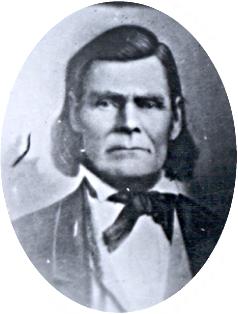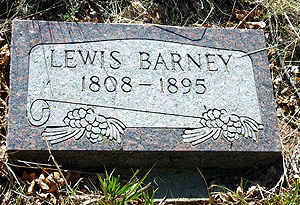After his mother died in childbirth when he was 17, his family was westbound again to Illinois winding up in the middle of the Grand Prairie, which looked to Barney "as boundless as the ocean." In 1832 he served in the Spy Battalion during the Black Hawk War, which involved such noted Americans as Abraham Lincoln, Jefferson Davis, Zachary Taylor and Albert Sidney Johnston.
After the war on April 11, 1832 he married Elizabeth Turner and took up farming. He built a house and fenced 80 acres of land. In 1838 however he left it all behind and headed for Iowa.
Barney was of the opinion “that religion of every kind was a hoax." When his brother in 1839 Luther joined the Mormon Church out of curiosity he decided to investigate the new religion. After meeting Joseph Smith he concluded Mormons were "an honest and industrious people” and was baptized in early 1840.
Barney once again sold out and bought a lot in Nauvoo from Hyrum Smith. He built a frame house on it, but "not being accustomed to city life," he also purchased a quarter section of land nearby.
Following the martyrdom of Joseph Smith, Barney was driven from his farm. He received his temple endowment in February 1846 and crossed the river soon thereafter. He left his family behind to join the Pioneer Camp's trek across Iowa and three months later he returned, packed up his family and left Nauvoo forever.
Barney went to the Salt Lake Valley with the 1847 Pioneer Company and returned to his family that fall, "thankful to find them alive." He settled in Iowa for five years along with what one minister called "herds of Mormons, who bring forth their young in the most prolific manner."
When Brigham Young called him to "gather to Zion," Barney crossed the plains again in 1852 with about 70,000 other emigrants, a record. On Blacks Fork his plural wife gave birth to a baby boy.
In Utah, he helped settle Palmyra, Spanish Fork, Springville, Springtown, Monroe, Burrville and Manti. With bullets "whistling round us tearing up the ground and cutting the brush at a rapid rate in every direction," Barney fought in the Walker War. He dammed Echo Canyon during the Utah War and served in Utah's Black Hawk War, "being exposed to hardship and danger of every kind." He survived grasshopper plagues, a reformation that "cast a gloom over the Saints," the United Order, working on the Union Pacific Railroad and even teaching school. Like most pioneers, he died broke.
On June 12, 1897, Barney's picture dominated the front page of The Salt Lake Tribune, part of its "Fifty Years Ago Today" tribute to Utah's pioneers. Actually, it was his brother Walter's picture, but The Tribune put Lewis' name on it. Lewis Barney never quit searching for that unexplored and unsettled wilderness.
Lewis Barney may not have been a member of the Mormon hierarchy, but he was never common. From his 1840 baptism in Illinois to his 1894 death in northwest Colorado, Barney wandered the western Mormon landscape struggling to establish an earthly patriarchal kingdom but failing to find the land and basic resources that would support his two wives and many children. The arid West refused to give place to such agrarian utopias. In spite of repeated failures, Lewis Barney never lost his vision of a family kingdom and his commitment to the religious beliefs on which it was based.
After his mother died in childbirth when he was 17, his family was westbound again to Illinois winding up in the middle of the Grand Prairie, which looked to Barney "as boundless as the ocean." In 1832 he served in the Spy Battalion during the Black Hawk War, which involved such noted Americans as Abraham Lincoln, Jefferson Davis, Zachary Taylor and Albert Sidney Johnston.
After the war on April 11, 1832 he married Elizabeth Turner and took up farming. He built a house and fenced 80 acres of land. In 1838 however he left it all behind and headed for Iowa.
Barney was of the opinion “that religion of every kind was a hoax." When his brother in 1839 Luther joined the Mormon Church out of curiosity he decided to investigate the new religion. After meeting Joseph Smith he concluded Mormons were "an honest and industrious people” and was baptized in early 1840.
Barney once again sold out and bought a lot in Nauvoo from Hyrum Smith. He built a frame house on it, but "not being accustomed to city life," he also purchased a quarter section of land nearby.
Following the martyrdom of Joseph Smith, Barney was driven from his farm. He received his temple endowment in February 1846 and crossed the river soon thereafter. He left his family behind to join the Pioneer Camp's trek across Iowa and three months later he returned, packed up his family and left Nauvoo forever.
Barney went to the Salt Lake Valley with the 1847 Pioneer Company and returned to his family that fall, "thankful to find them alive." He settled in Iowa for five years along with what one minister called "herds of Mormons, who bring forth their young in the most prolific manner."
When Brigham Young called him to "gather to Zion," Barney crossed the plains again in 1852 with about 70,000 other emigrants, a record. On Blacks Fork his plural wife gave birth to a baby boy.
In Utah, he helped settle Palmyra, Spanish Fork, Springville, Springtown, Monroe, Burrville and Manti. With bullets "whistling round us tearing up the ground and cutting the brush at a rapid rate in every direction," Barney fought in the Walker War. He dammed Echo Canyon during the Utah War and served in Utah's Black Hawk War, "being exposed to hardship and danger of every kind." He survived grasshopper plagues, a reformation that "cast a gloom over the Saints," the United Order, working on the Union Pacific Railroad and even teaching school. Like most pioneers, he died broke.
On June 12, 1897, Barney's picture dominated the front page of The Salt Lake Tribune, part of its "Fifty Years Ago Today" tribute to Utah's pioneers. Actually, it was his brother Walter's picture, but The Tribune put Lewis' name on it. Lewis Barney never quit searching for that unexplored and unsettled wilderness.
Lewis Barney may not have been a member of the Mormon hierarchy, but he was never common. From his 1840 baptism in Illinois to his 1894 death in northwest Colorado, Barney wandered the western Mormon landscape struggling to establish an earthly patriarchal kingdom but failing to find the land and basic resources that would support his two wives and many children. The arid West refused to give place to such agrarian utopias. In spite of repeated failures, Lewis Barney never lost his vision of a family kingdom and his commitment to the religious beliefs on which it was based.
Family Members
Advertisement
Advertisement





















